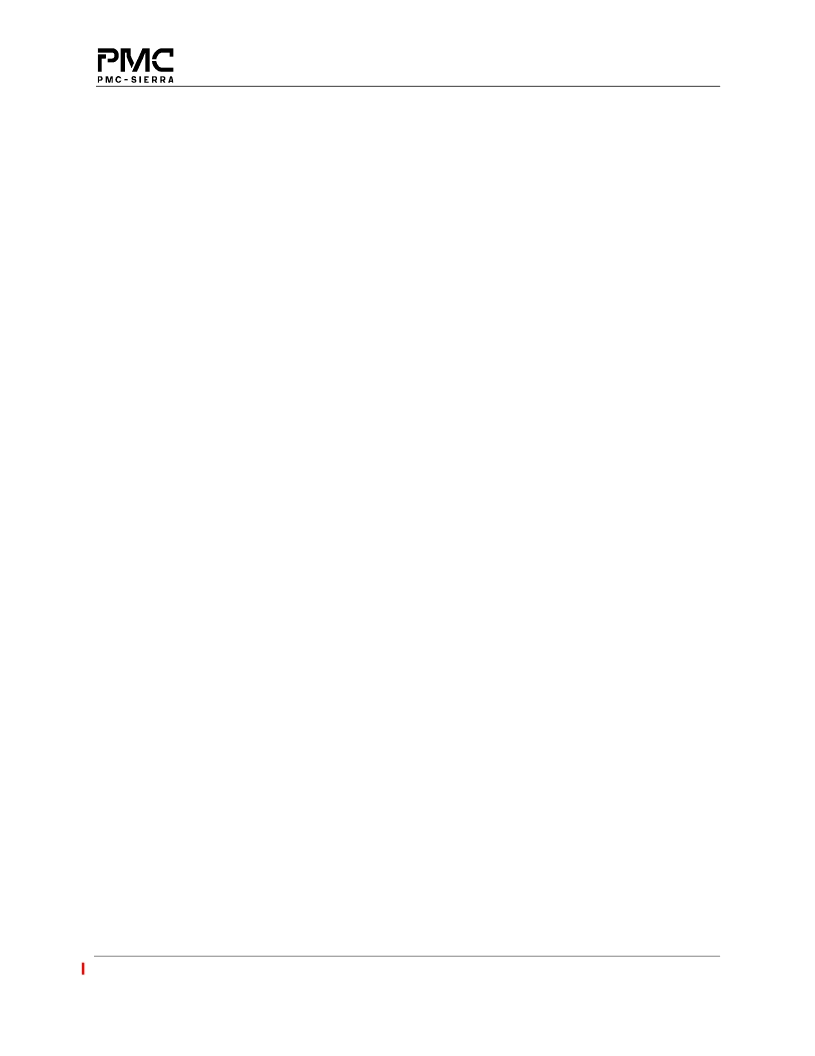- 您現(xiàn)在的位置:買賣IC網(wǎng) > PDF目錄373294 > RM7065A-400T Microprocessor PDF資料下載
參數(shù)資料
| 型號: | RM7065A-400T |
| 英文描述: | Microprocessor |
| 中文描述: | 微處理器 |
| 文件頁數(shù): | 23/52頁 |
| 文件大小: | 901K |
| 代理商: | RM7065A-400T |
第1頁第2頁第3頁第4頁第5頁第6頁第7頁第8頁第9頁第10頁第11頁第12頁第13頁第14頁第15頁第16頁第17頁第18頁第19頁第20頁第21頁第22頁當(dāng)前第23頁第24頁第25頁第26頁第27頁第28頁第29頁第30頁第31頁第32頁第33頁第34頁第35頁第36頁第37頁第38頁第39頁第40頁第41頁第42頁第43頁第44頁第45頁第46頁第47頁第48頁第49頁第50頁第51頁第52頁

Proprietary and Confidential to PMC-Sierra, Inc and for its Customers’ Internal Use
Document ID: PMC-2010145, Issue 3
23
RM7065A Microprocessor with On-Chip Secondary Cache Data Sheet
Released
The most commonly used write policy is write-back, which means that a store to a cache line does
not immediately cause memory to be updated. This increases system performance by reducing bus
traffic and eliminating the bottleneck of waiting for each store operation to finish before issuing a
subsequent memory operation. Software can, however, select write-through on a per-page basis
when appropriate, such as for frame buffers. Cache protocols supported for the data cache are as
follows:
1. Uncached
Reads to addresses in a memory area identified as uncached do not access the cache. Writes to
such addresses are written directly to main memory without updating the cache.
2. Write-back
Loads and instruction fetches first search the cache, reading the next memory hierarchy level
only if the desired data is not cache resident. On data store operations, the cache is first
searched to determine if the target address is cache resident. If it is resident, the cache contents
are updated and the cache line is marked for later write-back. If the cache lookup misses, the
target line is first brought into the cache, afterwhich the write is performed as above.
3. Write-through with write allocate
Loads and instruction fetches first search the cache, reading from memory only if the desired
data is not cache resident; write-through data is never cached in the secondary cache. On data
store operations, the cache is first searched to determine if the target address is cache resident.
If it is resident, the primary cache contents are updated and main memory is written, leaving
the
write-back
bit of the cache line unchanged; no writes occur to the secondary cache. If the
cache lookup misses, the target line is first brought into the cache, afterwhich the write is
performed as above.
4. Write-through without write allocate
Loads and instruction fetches first search the cache, reading from memory only if the desired
data is not cache resident; write-through data is never cached in the secondary cache. On data
store operations, the cache is first searched to determine if the target address is cache resident.
If it is resident, the cache contents are updated and main memory is written, leaving the
write-
back
bit of the cache line unchanged; no writes occur to the secondary cache. If the cache
lookup misses, only main memory is written.
5. Fast Packet Cache (Write-back with secondary bypass)
Loads and instruction fetches first search the primary cache, reading from memory only if the
desired data is not resident; the secondary cache is not searched. On data store operations, the
primary cache is first searched to determine if the target address is resident. If it is resident,
the cache contents are updated, and the cache line marked for later write-back. If the cache
lookup misses, the target line is first brought into the cache, afterwhich the write is performed
as above.
Associated with the data cache is the
store buffer
. When the RM7065A executes a
STORE
instruction, this single-entry buffer is written with the store data while the tag comparison is
performed. If the tag matches, then the data is written into the data cache in the next cycle that the
data cache is not accessed (the next non-load cycle). The store buffer allows the RM7065A to
相關(guān)PDF資料 |
PDF描述 |
|---|---|
| RM741D | Voltage-Feedback Operational Amplifier |
| KA741EI | Voltage-Feedback Operational Amplifier |
| KA741EID | Voltage-Feedback Operational Amplifier |
| KA741ID | Voltage-Feedback Operational Amplifier |
| RM741T | Voltage-Feedback Operational Amplifier |
相關(guān)代理商/技術(shù)參數(shù) |
參數(shù)描述 |
|---|---|
| RM7065C-466L-D004 | 制造商:PMC Sierra from Components Direct 功能描述:RM7065C-466L-D004 - Trays 制造商:PMC-Sierra 功能描述:PMC-Sierra RM7065C-466L-D004 Microprocessors |
| RM7065C-600T-D004 | 制造商:PMC-Sierra 功能描述: |
| RM707012 | 功能描述:通用繼電器 3PDT 16A 12VDC 86Ohm POWER RELAY RoHS:否 制造商:Omron Electronics 觸點形式:1 Form A (SPST-NO) 觸點電流額定值:150 A 線圈電壓:24 VDC 線圈電阻:144 Ohms 線圈電流:167 mA 切換電壓:400 V 安裝風(fēng)格:Chassis 觸點材料: |
| RM707024 | 功能描述:通用繼電器 16 AMP 24VDC 3PDT RoHS:否 制造商:Omron Electronics 觸點形式:1 Form A (SPST-NO) 觸點電流額定值:150 A 線圈電壓:24 VDC 線圈電阻:144 Ohms 線圈電流:167 mA 切換電壓:400 V 安裝風(fēng)格:Chassis 觸點材料: |
| RM707060 | 功能描述:通用繼電器 RoHS:否 制造商:Omron Electronics 觸點形式:1 Form A (SPST-NO) 觸點電流額定值:150 A 線圈電壓:24 VDC 線圈電阻:144 Ohms 線圈電流:167 mA 切換電壓:400 V 安裝風(fēng)格:Chassis 觸點材料: |
發(fā)布緊急采購,3分鐘左右您將得到回復(fù)。